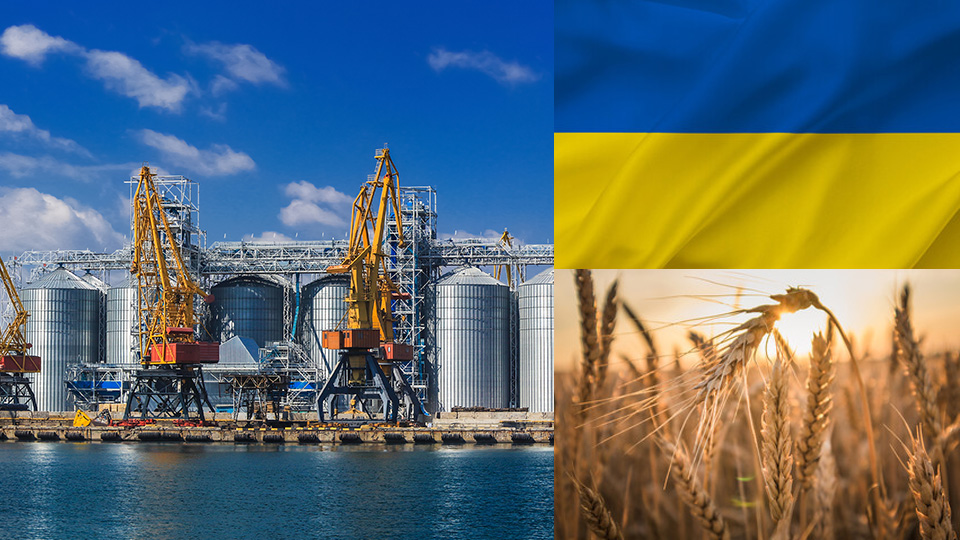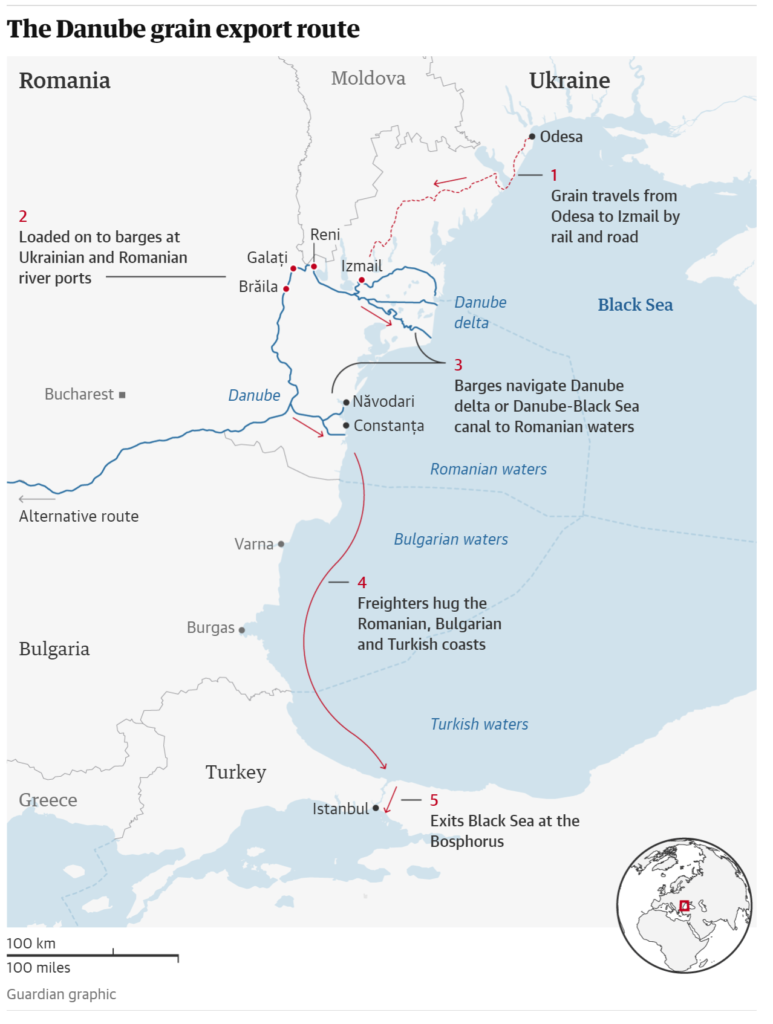Turning food into a weapon: how Russia resorted to one of the oldest forms of warfare

After failing to conquer Ukraine by conventional means, Russia tried an energy war, trying to hobble the power grid and freeze the nation into submission. Now it has launched a food war.
The mining of the Kakhovka dam in June threatens to turn southern Ukrainian farmland into a dustbowl. Since Moscow pulled out of an UN-brokered deal to allow Ukrainian grain exports through the Black Sea last month, it has announced a naval blockade of the country’s ports, and directly targeted food (destroying 220,000 tonnes of cereals awaiting export in silos) on the sea coast but also inland with attacks over the past two weeks on the Danube ports of Reni and Izmail.
The global cereal price index rose 10% in late July after Russia torpedoed the Black Sea grain initiative (BSGI), blocking a route that carried 32m tonnes over a year, more than half Ukraine’s total grain exports.
Some traders believe prices will have risen 20% by the end of the summer. Turkey’s president, Recep Tayyip Erdoğan, has appealed to Vladimir Putin to reconsider, but few involved in the grain business are optimistic that the deal can be revived.
By turning food into a weapon Russia has resorted to one of the oldest forms of warfare. Ancient armies burned the granaries of their foes to starve them into submission.
In this case, Ukraine’s economy has been further damaged and Russian exports have fetched higher prices. But the threat of starvation is thousands of miles away in the very poorest countries, that could be pushed further towards famine by higher prices and fewer humanitarian deliveries.
Ukraine provided half the wheat the World Food Programme (WFP) bought on global markets, which it shipped to people most in need in Afghanistan, Ethiopia, Kenya, Somalia, Sudan and Yemen. It was good quality, cheap and quick to ship from Odesa through the Bosphorus into the Mediterranean, then through the Suez Canal to Yemen and the Horn of Africa. The WFP now has to buy grain at a higher price and transport it from ports much further away.
The WFP spokesperson, Steve Taravella, said that without the Black Sea initiative, the organisation was “really going to struggle to feed the same amount of people”.
Because of historic levels of underfunding the WFP was already having to make impossible choices. “Because of a shortage of funds, the lack of which I have not seen in my 16 years here, WFP is either cutting the size of food rations given to individuals or cutting the numbers of people it can feed,” Taravella said, adding that the people the WFP was serving “were already hanging on by a thread”.
Cindy McCain, WFP executive director, said families in vulnerable countries struggling to survive were the “collateral damage” of the war.
More than 50 nations are supplying arms to Ukraine. They quickly established a process and forum, the Ramstein format, to coordinate deliveries but so far there has been no such concerted response for food security. Largely, that has been left to the market and piecemeal arrangements.
The EU has announced “solidarity lanes” – overland rail, road and inland waterway routes along which Ukraine can export food, while Croatia has offered the use of its port of Rijeka, and the Baltic states have offered their own ports.
However, westward land routes are complicated and expensive. Ukraine inherited railway tracks from the Soviet Union that are wider than most of those in Europe, so goods have to be transferred between trains at the border.
Under pressure from their own farmers, five neighbouring European countries have banned Ukrainian grain imports. Goods transiting those countries are in theory immune but there are still long lines of lorries held up on the Poland border by laborious veterinary checks on livestock.

There is discussion of creating “green corridors” that would allow Ukrainian exports to be transported without customs, sanitary or veterinary checks until they reached their destination port, but they have yet to be agreed.
The WFP also faces substantial costs shipping from Baltic or other western European ports to Africa or Asia.
“We have contracts in many other places, but those contracts are likely to come at a price. It will probably take longer to get to the places we need to go, and both of those things mean that the people who need the food the most are going to suffer,” Taravella said. “There are likely to be more deaths from lack of food than there would have been had this initiative continued.”
According to Aleksandr Korolyov, commercial director of Transferry, an Odesa-based warehousing company, the extra cost of exporting grain through Germany is up to €150 (£130) a tonne. “The logistic cost is too high, therefore this trade is absolutely unprofitable,” he said.
Ukraine has suggested that the excess should be paid by some international fund, but it is unclear whether the money would come from.
Korolyov said there were no good alternatives to the BSGI. The only one that made any economic sense was to use the Danube River ports in Ukraine, Izmail and Reni, or in Romania, at Galați and Brăila, where shipments could be loaded on to barges and ships. The vessels then pass through the three navigable channels of the Danube delta or the two branches of the Danube-Black Sea canal further south, for transfer to much bigger ocean-going freighters at the deepwater Romanian port of Constanța, able to accommodate cargo ships of 50,000 tons.
From there the freighters can hug the coast, remaining safely within Romanian, Bulgarian and Turkish territorial waters until they reached the Bosphorus strait.
Last year, this route accounted for about 20m tonnes. In theory and with some investment it could have a capacity of up to 35m tonnes a year, more than the total exported through the BSGI. The opening last month of a new €500m bridge at Brăila could boost truck traffic to the ports by up to 5m tonnes a year.
In practice, there are severe complications. Most importantly, the Russians are aware that the Danube route is a feasible alternative and are striving to cut it off. The drone strikes on Reni and Izmail in July and August destroyed warehouses and silos and the grain inside them – enough to feed 66 million people for a day, according to UN officials – but the most significant impact has been on the confidence of ship crews, owners and insurers.
“We understand that insurers are quite reluctant to explore any movement of ships without Russian Federation guarantees, which is what the Black Sea initiative provided,” a UN official said.
There are currently large traffic jams of ships off the coast from the Danube delta and Constanţa, waiting for decisions on whether it is safe to proceed. Even there, in coastal waters, they face the danger of mines and other floating debris left by the blasting of the Kakhovka dam.
Air defences could be mounted around the Ukrainian river ports but the Russians could attack in other ways. Two years ago, two river barges were sunk under mysterious circumstances. One western European investor said the sinkings were believed by Ukrainian and Romanian authorities to be a trial run by Russian intelligence to test how long it took to clear the river, in anticipation of further acts of sabotage.
As well as security considerations there are constraints on capacity. The Danube delta is congested and some channels are so narrow ships can only pass in one direction at a time. The canals can only take small ships and convoys of barges. There is also a shortage of vessels and crews, with rusting old barges being pulled into service, along with retired river pilots. Tugboats and pusher craft are operated in Romania by a small cartel, and foreign firms have found it hard to enter the market.
“Constanţa port could be expanded quite quickly,” a European investor said. “There are open spaces, and it’s a safe working zone and there is the potential to put up silos and rail connections.” There are discussions between the EU and Bucharest on expanding the port but Constanţa has an organised crime problem, the investor said, describing the expansion process as “slow and corrupt”.
The Danube route is also at the mercy of water levels, which limit the size of ship that can reach the river ports. For them to work effectively, it requires countries upstream – Germany, Austria, Hungary, and Serbia – to open their locks.
Given the complexities and cost of all the alternative routes to the BSGI, there are increasingly calls for a coordinating body – a civilian Ramstein format.
Korolyov, like many Ukrainian officials, would like to see a specially created body address the problems. “I see all existing international institutions as being useless and amorphous, afraid to speak out against Russia, or do anything to stop Putin,” he said. “They don’t carry out their duties.”
So far the Biden administration has been wary of such an institutional fix.
James O’Brien, head of the US state department’s office of sanctions coordination, said: “I don’t believe a single entity is the answer to this. I think one of the things that works in the global food system is that we have thousands of smaller actors, each pursuing a way to move grain around.”
Others argue that when Russia is treating food as a weapon of war, Ukraine, the west and world’s hungry population will lose if it waits for the market to solve the resulting crisis.
“The idea would be to enable the market to function, which it isn’t when one player is weaponising and destroying one part of the system,” said Fiona Hill, former senior director for European and Russian affairs at the US national security council, who is now focused on food security at the Brookings Institution in Washington DC.
“It’s applying the same general rationale we took to dealing with energy and the crisis we confronted as a result of the war and applying it to grain and other food.”
Read also
Wheat in Southern Brazil Impacted by Dry Weather and Frosts
Oilseed Industry. Leaders and Strategies in the Times of a Great Change
Black Sea & Danube Region: Oilseed and Vegoil Markets Within Ongoing Transfor...
Serbia. The drought will cause extremely high losses for farmers this year
2023/24 Safrinha Corn in Brazil 91% Harvested
Write to us
Our manager will contact you soon



